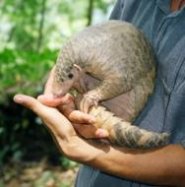 The Indian Pangolin (Manis crassicaudata) is a species of pangolin found in, well, India. The Indian Pangolin is also found in Sri Lanka and is an insectivore primarily. The Indian Pangolin is one of the few that will climb trees, however it is not strictly arboreal (tree dwelling) and will dig burrows. Like all pangolins it has large armored scales and will quickly curl into a ball when it feels threatened, with its tail covering its head for protection. The Indian pangolin grows to a weight of 17-19 lbs (8-9 kilograms) and their head and body length reaches 2.0-2.2 ft (60-65 centimeters) with their armored tails adding 1.5-1.8 ft (45-55 centimeters) to the overall length. Their skin is a brownish color, while the scales can be brownish to yellowish in appearance, but are mostly kept with their surrounding to better help them go un-noticed.
The Indian Pangolin (Manis crassicaudata) is a species of pangolin found in, well, India. The Indian Pangolin is also found in Sri Lanka and is an insectivore primarily. The Indian Pangolin is one of the few that will climb trees, however it is not strictly arboreal (tree dwelling) and will dig burrows. Like all pangolins it has large armored scales and will quickly curl into a ball when it feels threatened, with its tail covering its head for protection. The Indian pangolin grows to a weight of 17-19 lbs (8-9 kilograms) and their head and body length reaches 2.0-2.2 ft (60-65 centimeters) with their armored tails adding 1.5-1.8 ft (45-55 centimeters) to the overall length. Their skin is a brownish color, while the scales can be brownish to yellowish in appearance, but are mostly kept with their surrounding to better help them go un-noticed. The Indian Pangolin belongs to the genus Manis, which has seven other species of pangolins, however the pangolins themselves are monotypes, meaning that their family Manidae has no other living genus but Manis, and their order Pholidota has no other living family except Manidae. Additional features of pangolins include their tongues, which can extend to over 9 inches (20-23 centimeters) and has muscles that extend back to its pelvic area in order to anchor the massive tongue.
The Indian Pangolin prefers hilly areas to planes, as long as they are tropical, and will sleep inside hollowed trees or dig a 20 foot deep burrow (6 meters) when the dirt is soft enough. However if the dirt is not as soft as that, they will dig 6 foot deep burrows out of necessity. Once inside their burrow, they will cover the doorway in loose dirt to hide it from predators and other invaders. The Indian Pangolin lives a mostly solitary life, having little contact with others until the breeding season starts, which is about the only time you will find two in the same burrow. If disturbed they can emit and acidic foul smelling liquid from glands - similar to how a skunk would, and can cause further irritation to any unlucky predator.
Gestation (pregnancy) times for the Indian Pangolin are roughly 65-75 days, with the average litter size being two or just one, and can occur at any season and time throughout the year. Other information, such as full maturity or rearing habits for the Indian Pangolin are as of yet unknown until further observation can be made. Currently the Indian Pangolin is listed as near-threatened by the International Union for the Conservation of Nature and Natural Resources (IUCN) and are dependant on further conservation. However human beings are one of the largest threats to the Indian Pangolin, as encroachment on habitat takes a dire toll on populations - which is not helped by poaching for food and scales which are though by many (incorrectly) to be a pleasure inducing substance. Other threats do include natural predators; however without the pressure from human beings it is likely that it would not endanger the species in the same way.
Here are some interesting facts about Indian Pangolins:
- Over 1/3 to 1/4 of the Indian Pangolin's weight is from its scales.
- The Indian Pangolin's scales are made out of the same material as the human fingernail - Keratin.
- Indian Pangolins have a highly developed problem-solving brain, and are capable of using it in the wild, and to escape back to the wild when in captivity.
- Conservationists teamed with Authorities continue to save Pangolins from illegal exportation to countries such as China where populations believe the Pangolin to be a delicacy and also parts to hold medicinal values.
- Indian Pangolins, like other pangolins, cannot walk on their front claws, and so curl them back and walk on their knuckles.
- Indian Pangolins lack teeth, as do other pangolins, and have a two chambered stomach that crushes their food for them.
Keywords: scale , claw , nocturnal
The Indian pangolin, thick-tailed pangolin is listed as Near Threatened (LR/nt), is close to qualifying for or is likely to qualify for a threatened category in the near future, on the IUCN Red List of Threatened Species
Some facts about the
Indian pangolin
Adult weight : 13.015 kg (28.633 lbs)
Gestation : 67 days
Litter size : 1
Weight at birth : 0.35 kg (0.77 lbs)
Basal metabolic rate : 7 W
Body mass : 15.91 kg (35.002 lbs)
Temperature : 33.85 °C (92.93 °F)

Custom Search